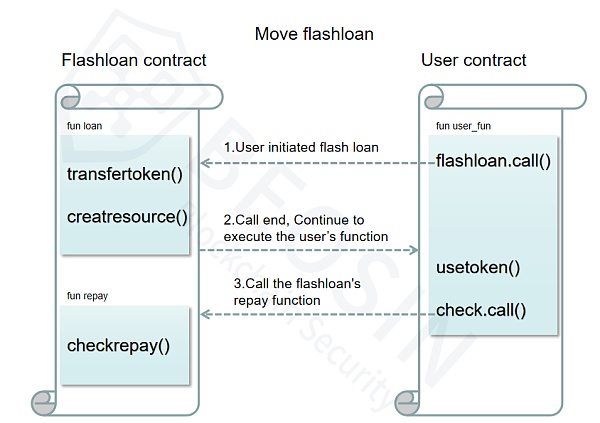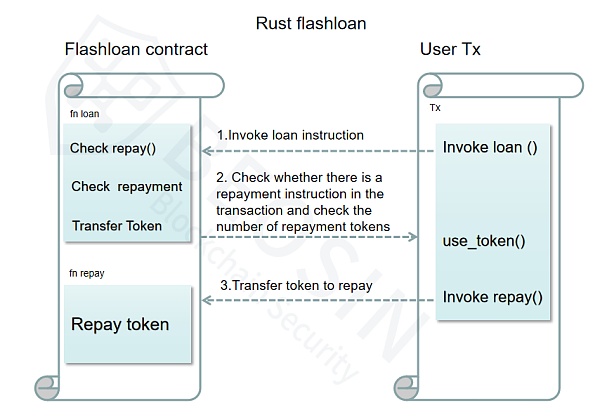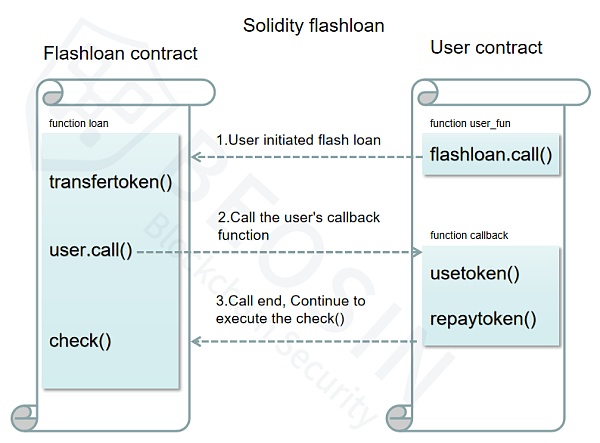作者:Beosin安全研究專家Sivan
閃電貸是一種無抵押借款的服務,由於其擁有無需抵押便能藉出資金的特性,使得資金利用率大大提高。在常見的以太坊閃電貸中,是透過以太坊交易機制來確保可以進行無抵押借出資金,以太坊中一個交易可以包含很多步驟,如:借款、兌換、使用、還款等,所有的步驟相輔相成,若其中某一個或多個步驟發生錯誤,都會導致本次的整個交易被回溯。
隨著區塊鏈生態發展,出現了大量公鏈以及合約程式語言,例如:除了Solidity之外最常見的Move和Rust,這些合約程式語言有本質上的區別,框架與程式設計理念也有所不同,本文章我們來比較Solidity閃電貸實現方式與Move以及Rust閃電貸實現方式有何不同,同時可以初步了解一下各種語言的程式設計理念。
Solidity相關閃電貸:
Solidity的閃電貸是基於Solidity支援動態調用這一特性來設計的,何為動態調用,也就是solidity支援在調用一個函數的過程中,動態傳入需要調用的位址,如下例程式碼。每次呼叫都可以傳入不同的位址,根據這個特點,便出現了solidity閃電貸的實現邏輯。
function callfun(address addr) public { addr.call();}
如下程式碼,將閃電貸抽象化成了3個核心功能,
1、首先直接將資金發送給呼叫者;
2、再調用呼叫者合約,從而讓呼叫者使用這些資金;
3.呼叫者使用結束,檢查是否歸還資金以及手續費,如果檢查失敗則回滾交易。 (此處也可以直接使用transferfrom函數將呼叫則資金轉移回來)
function flashloan(uint amount, address to) { transfer( to, amount); // 發送資金給呼叫者 to.call();//呼叫呼叫者的合約函數 check();//檢查是否歸還資金}
如下圖,為Solidity語言中閃電貸的實現流程:
下列程式碼為真實專案Uniswap閃電貸邏輯。程式碼範例:
function swap(uint amount0Out, uint amount1Out, address to, bytes calldata data) external lock { require(amount0Out > 0 || amount1Out > 0, ‘UniswapV2: INSUFFICIENT_OUTPUT_AMOUNT’); require(amount0Out < _reserve0 && amount1Out < _reserve1, 'UniswapV2: INSUFFICIENT_LIQUIDITY'); uint balance0; uint balance1; { address _token0 = token0; address _ uint1 = tokenress { address _token0 = token0: address _token1 = tokenress 1; INVALID_TO '); /**將資金轉給使用者**/ if (amount0Out > 0) _safeTransfer(_token0, to, amount0Out); if (amount1Out > 0) _safeTransfer(_token1, to, amount1Out);
/**呼叫使用者指定的目標函數**/ if (data.length > 0) IUniswapV2Callee(to).uniswapV2Call(msg.sender, amount0Out, amount1Out, data); balance0 = IERC20(_token0).balanceOf(address(thisanceOf(address(thisanceOf(address(thisanceOf(address) )); _reserve1 – amount1Out) : 0; require(amount0In > 0 || amount1In > 0, ‘UniswapV2: INSUFFICIENT_INPUT_AMOUNT’); { uint balance0Adjusted = balance0.mul(1000).subbalm-0003); .mul(1000).sub(amount1In.mul(3)); /**檢查使用者是否歸還資金以及手續費**/ require(balance0Adjusted.mul(balance1Adjusted)>=uint(_reserve0).mul(_reserve1). mul(1000**2), ‘UniswapV2: K’);
} _update(balance0, balance1, _reserve0, _reserve1); emit Swap(msg.sender, amount0In, amount1In, amount0Out, amount1Out, to);}
Move相關閃電貸:
Move閃電貸和solidity設計想法不同,move中沒有動態調用這一個特性,在所有函數調用過程之前,都必須確定調用流程,明確調用合約地址是什麼,所以無法像solidity裡面那樣動態傳入地址再進行調用。
那麼move能實現閃電貸功能嗎?當然可以,move的特性使得人們設計出與solidity實現方式不同的閃電貸。
在Move中,將資料和執行程式碼分離,造就了Move VM獨特的資源-模組模型。在這種模型中,不允許資源在交易結束時未被銷毀或保存在全域儲存中,因此Move 中的資源存在一種特殊的結構體——燙手山芋(Hot Potato),它是一個沒有任何能力修飾符的結構體,因此它只能在其模組中被打包和解包。
*Move 能力詳情:
https://move-book.com/advanced-topics/types-with-abilities.html
因此在move語言中的閃電貸實現,巧妙地利用了這種模式,將閃貸和還款操作抽象為兩個函數進行處理,中間產生借貸資源記錄借貸情況,該資源並沒任何能力,只能夠在還款函數中透過解包的方式將借貸資源給消耗掉,因此借貸操作必須和還款操作綁定在同一個操作中,否則閃電貸交易就會失敗。
如下圖,為move語言中閃電貸的實現流程。

如下程式碼,loan與repay兩個函數結合便可以實現閃電貸。需要使用閃電貸服務的用戶,先呼叫loan函數申請借款。函數會先判斷是否有足夠的資金提供借款,然後將資金發送給調用者,計算好費用後,創建一個沒有任何能力的資源」receipt 」並返回給調用者。調用者在自己的合約中使用借貸的資金,最後需要將”receipt”返還到repay函數,並且附帶歸還的資金。在repay函數中,首先將」receipt」資源解構,以確保交易成功執行,隨後判斷用戶歸還資金是否與先前計算好的資金數量相同,最後完成整個交易。
程式碼範例:
struct Receipt
Rust相關閃電貸:
Rust因其提供記憶體安全、並發安全和零成本抽像等特性。也用在了區塊鏈智能合約語言開發中,接下來我們以Solana智能合約(Program)為例來講解使用Rust開發實現的閃電貸。
Solana VM 也將資料和執行程式碼進行了分離,使得一份執行程式碼可以處理多份資料副本,但與Move不同的是,陣列帳戶是透過程式派生的方式完成的,並且沒有類似於Move特性的限制。因此Solana Rust不能夠使用Move的方式實現閃電貸,並且Solana Rust動態調用指令(等同於理解為合約的函數)遞歸深度限制為4,使用Solidity動態調用的方式同樣不可取。但在Solana中每個指令(instruction)調用在交易中是原子類型的,因此在一筆交易中可以在一個指令中檢查是否存在另一個指令。而Solana中的閃電貸依賴此了特性,Solana閃電貸在閃貸的指令中將檢查閃電貸交易中是否存在還款的指令,並檢查還款的數量是否正確。
如下圖,為Rust語言中閃電貸的實現流程:

程式碼範例:
pub fn borrow(ctx: Context
let mut i = current_index + 1; loop { // 遍歷交易序列中的指令, if let Ok(ixn) = solana::sysvar::instructions::load_instruction_at_checked(i, &ixns) { // 查找是否同時呼叫了該查找是否同時呼叫了該查找程式的中還款指令(repay) if ixn.program_id == *ctx.program_id // 檢查invoke data 中函數簽章&& u64::from_be_bytes(ixn.data[..8].try_into().unwrap()) == REPAY_OPCODE && ixn.accounts[2].pubkey == ctx.accounts.pool.key() { // 檢查函數invoke data 中amount數量是否正確 if u64::from_le_bytes(ixn.data[8..16].try_into().unwrap()) == amount { break; } else { return Err(AdobeError::IncorrectRepay.into()); } } else { i += 1; } }else { return Err(AdobeError:: NoRepay.into()); } } let state_seed: &[&[&[u8]]]= &[&[ &State::discriminator()[..]&[ctx.accounts.state.bump]]]; let transfer_ctx = CpiContext::new_with_signer( ctx.accounts.token_program.to_account_info(), Transfer { from: ctx.accounts.pool_token.to_account_info(), to): ctx.accounts.user_token. ctx.accounts.state.to_account_info(), }, state_seed, ); // cpi 轉帳token::transfer(transfer_ctx, amount)?; ctx.accounts.pool.borrowing = true; Ok(())}
// REPAY// receives tokenspub fn repay(ctx: Context
let transfer_ctx = CpiContext::new_with_signer( ctx.accounts.token_program.to_account_info(), Transfer { from: ctx.accounts.user_token.to_account_info(), to: ctx.accounts.pool_toct.to_account_account. user.to_account_info(), }, state_seed, );
// 還款 token::transfer(transfer_ctx, amount)?;
// 更新帳本狀態 ctx.accounts.pool.borrowing = false;
Ok(())}
對比三種語言的閃電貸流程,均為借款->使用->還款三步,只是由於語言的特性,在實現方式上有所不同。
Solidity支援動態調用,所以可以在單一函數中完成整個交易;
Move不支援動態調用,由於資源的特性,需要使用兩個函數進行借款和還款邏輯;
Rust(Solana)能支援動態調用,但是僅支援4層CPI調用,使用CPI實現閃電貸將產生局限性,但是Solana每個指令都是原子類型,並且支持指令自省,因此使用指令自省的方式實現閃電貸是較好的方式。


